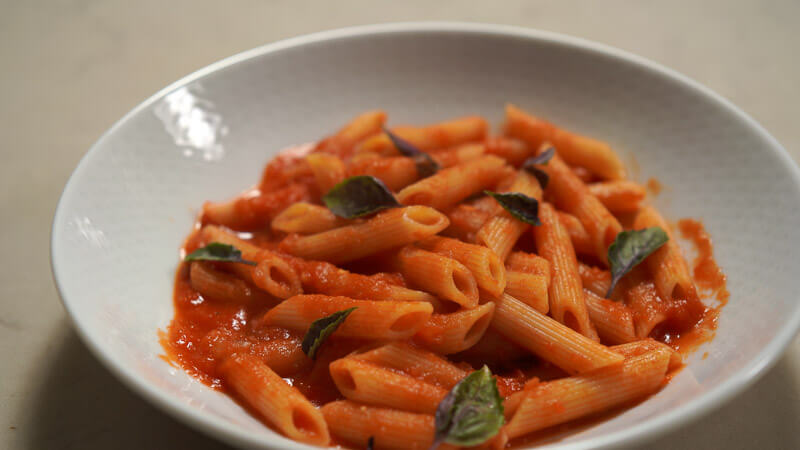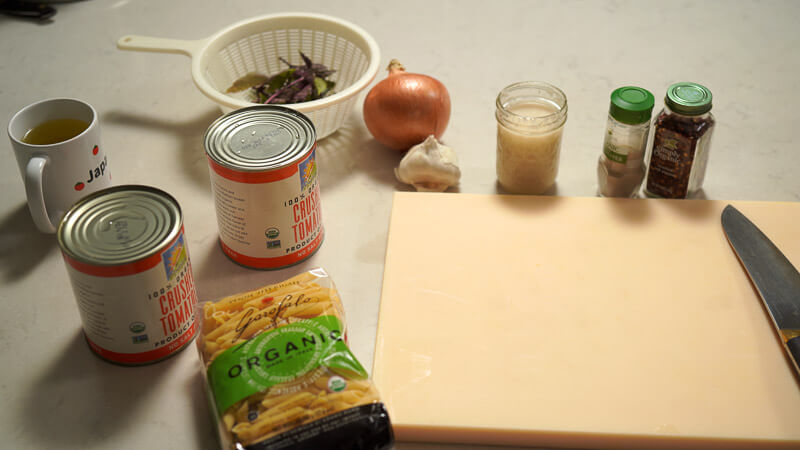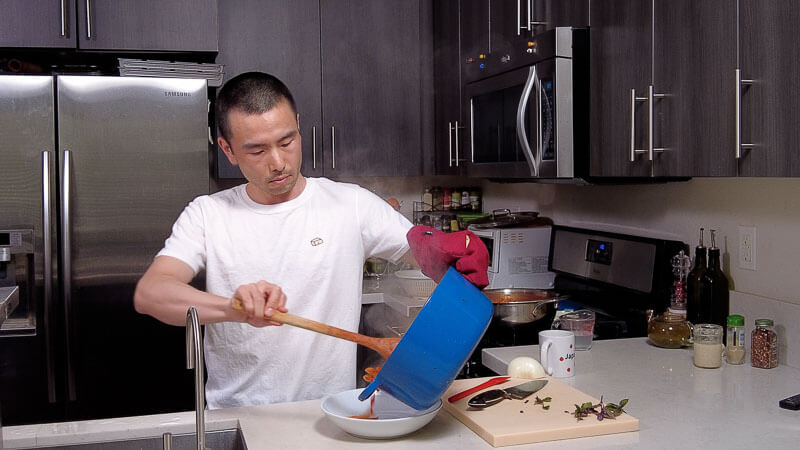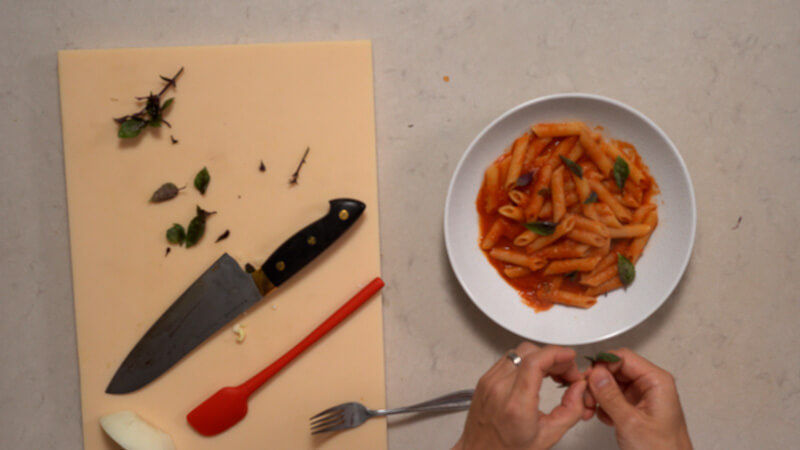Want a simple and tasty Japanese-style pasta recipe? Well, regardless if you’ve had Japanese-style pasta or not, here is a good one to start with. You only need one key ingredient, can you guess what that might be?

Make your pasta like it’s made in Italy (or Japan!)
It is said that Italian food is amazingly delicious because of the quality of the ingredients that are used, and I think that’s absolutely true, at least based on my experiences traveling and eating in the country. What about you? Let me know in the comments. You may be surprised to hear that some of the best Italian food I’ve had outside of Italy was actually in Japan. And you may have noticed that the supermarkets or farmers markets, that the product actually also looks like it’s pretty high quality, not only on the surface level, so the way that it looks, but also if you’ve actually bitten into a piece of fresh fruits, or maybe even had a chance to cook with some of the vegetables or other products there, you may have noticed that it tastes quite good.

So similar to Italy, I think the farmers in Japan actually take really good care of their crops, and the results of that care are amazing, delicious flavor, good flavor, high-quality flavor. So, for example, just using one of the simplest ingredients using a low-quality olive oil compared to something that’s a little bit higher quality, you may have experienced that there is quite a difference in the flavor. Not only that, but also the aromatic aspect and the mouthfeel or the way that it feels in your mouth, and aftertaste. And if you have really high-quality ingredients to start out with when you’re cooking, everything else will just take care of itself.

Ingredients for the pasta
So for this recipe, we’re going to be keeping things pretty simple. You’re going to be needing about a pound of spaghetti, 228-ounce cans of tomato, if you can get whole tomatoes that are also organic and from Italy, even better. A little bit of fresh Shiso or Perilla if you can find it. Alternatively, red or green basil, about 2 cups of onion thinly sliced which helps them to cook quickly. About 2 cloves of garlic, 3 tablespoons of shiokoji, my favorite fermented rice product, have a little bit of salt added to it. About a half teaspoon of red pepper flakes, Dash of white pepper.

So the first thing that you’re going to want to start with is cooking the onions. You want them to slightly brown to help increase some of that flavor and cut down on the sharpness or the spiciness of the onions. If you can get red onions, they’re going to be a little bit sweeter. And they help to make things a little bit more mellow as compared to white or brown onions. And once you have those onions browning a little bit, you can go ahead and throw in the garlic, and then once the garlic has cooked for about 45 seconds or so, throw in the tomato sauce along with the shiokoji and the pepper. You’re going to want to cook that for about 20 minutes, roughly 15 to 20 minutes, to help all of those flavors meld together.
Tomato Pasta sauce made right
Also, if you want a more concentrated or less saucy pasta sauce, you might want to cook it down, maybe even a little longer. In the meantime, you can get your pasta started. So usually, I use about four quarts of water, with one tablespoon of salt, and add the pasta in and let it cook until before it’s al dente so that you can actually finish cooking the pasta in the tomato sauce. So that helps the pasta to absorb a little bit of that tomato flavor versus if you were just to combine the al dente pasta and the sauce and then serve it right away. So I usually cook it after the pasta has been drained for anywhere about 1 to 2 minutes at the most. And by that time. Once you cook the pasta with the sauce for 1 to 2 minutes, it will become al dente in that texture if that’s what you’re going for.

So that was the first tip for you whenever I have a saucy sauce. I usually like to finish the pasta cooking in the sauce that I’m going to be using to season the pasta. The second thing is if you like things saucy. If you don’t like thick sauces, but you’d prefer a runnier sauce, you can also save some pasta water after the pasta is done cooking and added to your sauce to thin it out if desired.
Variations on the Japanese tomato pasta sauce
If you can’t find shiokoji, which is the key ingredient to making this traditional. I guess Italian Pomodoro pasta, Japanese. Then what you can do instead is use a little bit of soy sauce as a substitute, alternatively, miso paste. So similar amount, maybe 2 to 3 Tablespoons roughly. It’s going to taste a little bit different because shiokoji doesn’t have as strong of a flavor, but it’ll give you a little bit of a different taste profile compared to just using salt.

If you’re open to putting a little bit more work into making this pasta even more gourmet or more homemade, so you can also consider making fresh pasta making that from scratch as compared to using dried pasta. Also, taking that a step further, if you have a garden or you’re into gardening and growing your own produce your tomatoes, for example, you can grow your own tomatoes. And not only use them but roast them, which is going to take things even more to the next level than they already are with the shiokoji.

Making this pasta sauce worth it (cooking smart)
And because this Japanese style pasta is relatively simple, what you can do to make sure that you get the most bang for your buck, or leverage the time that you’re spending cooking, is to make a big batch of the sauce and freeze it for a later time in the year. Maybe a day that you don’t feel like cooking, if you froze your pasta sauce, all you’re going to do is thaw it and then cook some pasta, and then you have a delicious meal ready to eat within just a few minutes, without cooking too much. You can even use this pasta sauce on pizza if you wanted to put a tomato sauce on your pizza. If you want to get some bread into a tomato-based sauce, that could work as well. The last thing that I have for you is to make this Japanese-style pasta recipe your own.
Making this pasta sauce your own
So if you don’t have all of the ingredients, you can make a few substitutions which I like to do every now and then. One is to substitute the onions with some shallots, a different colored onion, or even a mixture. You can also change up the pepper instead of using white pepper, use black pepper, green peppercorns, red peppercorns, or a blend of peppercorns to give you a little bit of a different flavor profile. You can also use, like I mentioned, Shiso; if you don’t find that can’t find that use some parsley. Maybe even consider leaving one of those out for a different flavor altogether or even throwing some cheese.

Tips for making the Japanese pasta a success
Once your pasta sauce has cooked for about 20 minutes or so, you can taste it. See if you want things a little bit saltier or a little bit sweeter. You can adjust with a bit more shiokoji or put in a little bit of sugar or honey if you want things on the sweeter side. Depending on the types of tomatoes you’re using, some may be a little bit more tart or acidic as compared to others. Once your tomato sauce is ready, I usually just put it on to simmer while the pasta finishes cooking. Then once the pasta is done, just before al dente, I’ll throw some in how much I’m going to eat and then mix the pasta with the sauce, cook it for 1 to 2 minutes and then serve.

Tips for buying dried pasta
One other tip regarding the actual pasta that you’re going to be using, if you aren’t going to be making pasta from scratch using fresh pasta, make sure if you can, to get a dried pasta that has been made with bronze dyes. The way that you can tell is obviously by looking at the package and seeing how the pasta was created or produced. Alternatively, you can look at the pasta itself and see if there is a powdery sort of surface or irregular surface, a rough-looking surface. It usually indicates that it’s going to be a pasta that will help the sauce cling to it, thanks to the rough surface texture, compared to something smooth; that’s usually what I look for when I’m searching for or buying dried pasta. In addition, if it is made in Italy, that’s also a plus in my book as well. Try different brands to see if you can tell the difference in terms of the flavor or if it’s even worth paying for something more that has been imported as compared to an American-made pasta, and see for yourself what your preferences are. (One of my favorites is Rustichella)
So let me know what you think of this video. If you enjoyed it, give me a thumbs up to let me know. Subscribe for more cooking videos and recipes just like this one and consider sharing this with a friend if you’ve gotten any value out of it because if you’ve gotten value out of it, maybe they will as well.

Do you think you’ll be trying this recipe? Let me know if you will with a comment. If you have any questions or feedback, leave them below. I’m always looking to make things better for next time. Until then, I guess I will see you in my next video.
PrintTomato pasta with shiokoji
Ingredients
- 1lb spaghetti
- 2 cups onion, thinly sliced
- 2 cloves garlic
- 2 28 cans tomato
- 3 Tbsp shiokouji
- ½ tsp red pepper flakes
- Dash white pepper
- Shiso or basil
Instructions
- Prepare your vegetables and measure out seasonings and set aside.
- Cook your pasta in salted water until just before al dente. Reserve about ½ cup pasta water to thin sauce, if desired. Then drain and set aside until sauce is ready.
- Using a large sauté pan on medium high heat, add olive oil and onions. Cook for 10-15 minutes until they start to brown. Stir occasionally and add a few dashes of water to help browning (without adding additional oil). browning the onions helps to bring out additional flavor.
- Add in tomatoes and remaining ingredients. Cook sauce for another 10-15 minutes stirring occasionally. If desired use an immersion blender or regular blender to puree into a smooth sauce.
- Once sauce has cooked, stir in shiso or basil if using. Taste for flavor, you can add a few teaspoons of sugar or honey to sweeten or a bit of shiokoji or soy sauce to make saltier. Add some freshly cracked pepper for an additional layer of flavor.
- Combine with cooked pasta and cook another 1-2 minutes to finish cooking the pasta to desired consistency.
- Serve immediately







Konnichiwa! (Hello!) I'm Pat Tokuyama, a Japanese tofu cookbook author, who travels for music, food, and adventure. If you like Japanese tea, checkout some of the newestorganic japanese tea, matcha bowls and noren and more!
** Curious about the Plant Based Japanese Cooking Club? ** Learn more here!